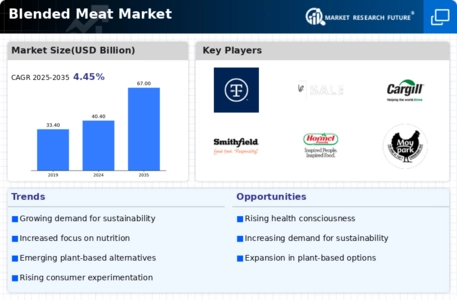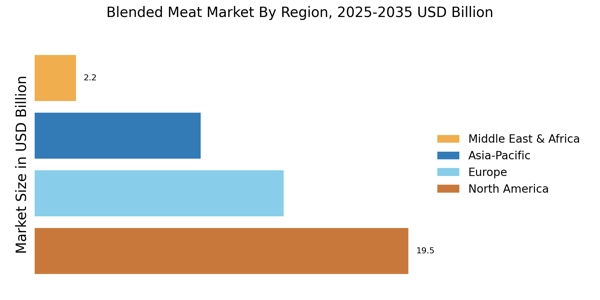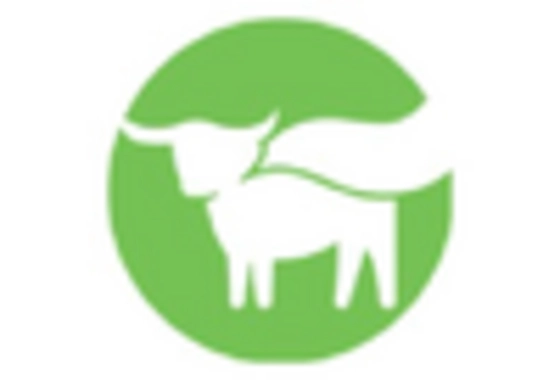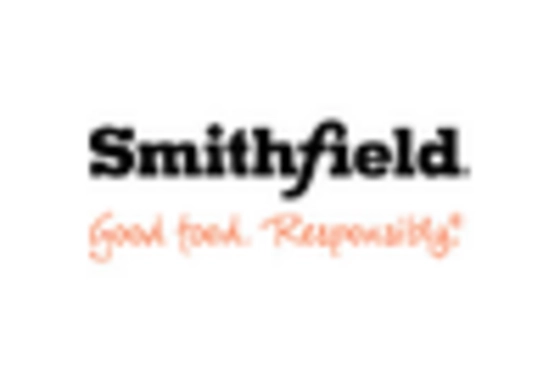Changing Consumer Preferences
Changing consumer preferences are a significant driver of the Blended Meat Market. As more individuals adopt flexitarian or plant-based diets, the demand for blended meat products is on the rise. This shift is influenced by a desire for healthier eating, environmental sustainability, and ethical considerations regarding animal welfare. Surveys indicate that nearly 40% of consumers are actively seeking to reduce their meat consumption, which bodes well for the blended meat segment. The Blended Meat Market is well-positioned to cater to this evolving consumer landscape, offering products that satisfy both meat lovers and those looking to incorporate more plant-based options into their diets. This adaptability is likely to enhance market growth in the coming years.
Health Benefits of Blended Meat
The Blended Meat Market is experiencing a surge in demand due to the increasing awareness of health benefits associated with blended meat products. These products, which combine traditional meat with plant-based ingredients, offer a lower fat content and higher fiber levels, appealing to health-conscious consumers. Research indicates that blended meat can reduce saturated fat intake by up to 30%, making it a favorable option for those seeking healthier dietary choices. As consumers become more informed about nutrition, the market for blended meat is likely to expand, with projections suggesting a growth rate of approximately 10% annually. This trend reflects a broader shift towards healthier eating habits, positioning the Blended Meat Market as a key player in the evolving food landscape.
Cost-Effectiveness of Blended Meat
The Blended Meat Market is also driven by the cost-effectiveness of blended meat products. As the prices of traditional meat continue to rise due to various factors, including supply chain disruptions and increased feed costs, blended meat offers a more affordable alternative. By incorporating plant-based ingredients, manufacturers can reduce production costs while still delivering high-quality products. This price advantage is particularly appealing to budget-conscious consumers and families. Market analysis indicates that blended meat products can be priced 20 to 30% lower than their all-meat counterparts, making them an attractive option for a wider audience. This economic factor is likely to contribute to the sustained growth of the Blended Meat Market.
Culinary Innovation and Versatility
The Blended Meat Market is thriving due to culinary innovation and the versatility of blended meat products. Chefs and food manufacturers are increasingly experimenting with various plant-based ingredients to create unique flavor profiles and textures. This innovation not only enhances the appeal of blended meat but also allows for a broader range of applications in diverse cuisines. The market has seen a rise in products such as blended burgers, meatballs, and sausages, catering to a wide array of consumer preferences. As culinary trends evolve, the demand for innovative blended meat options is expected to grow, potentially leading to a market expansion of around 15% over the next few years.
Sustainability and Environmental Impact
Sustainability concerns are increasingly influencing consumer choices, thereby driving the Blended Meat Market. The production of blended meat is often associated with a lower carbon footprint compared to conventional meat, as it utilizes fewer resources and generates less waste. Studies suggest that blending plant-based ingredients with meat can reduce greenhouse gas emissions by up to 50%. This aligns with the growing consumer preference for environmentally friendly products, as individuals seek to minimize their ecological impact. As awareness of climate change and resource depletion rises, the Blended Meat Market is poised to benefit from this shift, with many companies adopting sustainable practices to attract eco-conscious consumers.


















Leave a Comment